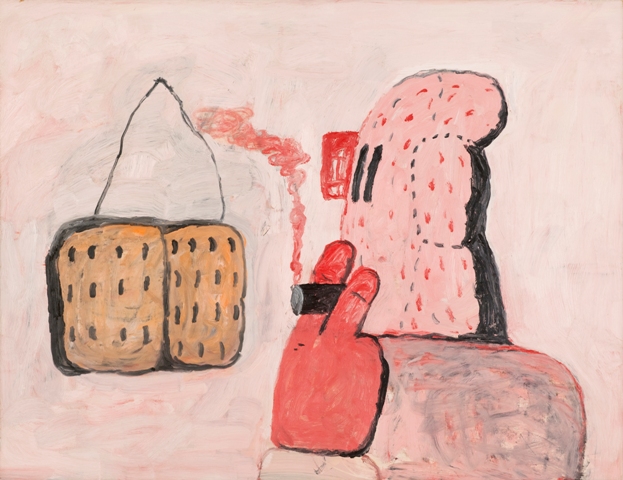
Philip Guston. Untitled, 1971. Oil on paper mounted on canvas. Private Collection, Woodstock, NY. © Estate of Philip Guston; image courtesy McKee Gallery, New York, NY.
Would you risk a highly successful career, replete with public recognition, to pursue a line of creative inquiry that was tacitly forbidden? That is exactly what Philip Guston did. Virtually self-taught, Guston’s early social realist works showed the influence of Picasso, Piero della Francesca, and Mexican mural painting. His abstract expressionist works were widely admired for their refined, elegant handling. In 1970, Guston exhibited his work at the prestigious Marlborough Gallery in New York. Prepared to embrace Guston one of America’s leading proponents of abstraction, critics were shocked to see paintings that showed hooded Klan-like figures and other politically charged imagery depicted in a deliberately clumsy, cartoon-like manner. Critics such as Hilton Kramer of The New York Times reacted with disbelief and derision.
What made Guston change his style? The news in the late 1960s was about Vietnam, anti-war demonstrations, and the violence at the Democratic National Convention. Guston felt that he could no longer justify the luxury of adjusting a red to a blue in his abstract painting when the world was in turmoil. Looking back, he recalled, “I was sick and tired of all that purity. I wanted to tell stories again.”
Guston wanted to invent a new visual language that reflected what was going on in the world.
Though today it is possible to work in a myriad of styles in 1970 that was not the case, and most art critics promoted abstraction as the only legitimate approach. Works with recognizable imagery that reflected current political themes were anathema because they recalled Russian Socialist Realism, an unwelcome association during the Cold War.
The works in Philip Guston, Roma were created during a six month sojourn in Rome immediately following the Marlborough exhibition. Guston was so unsettled by the negative critical reaction to his exhibition that he did not make art work for several months. As I mentioned in an earlier post, he didn’t even bring his art supplies. What enabled Guston to get out of his slump and start working again? Harold Rosenberg, a well-known critic, wrote a favorable review of Guston’s Marlborough exhibition in The New Yorker. Rosenberg titled his review, “Liberation from Detachment” and said that “Guston is the first to have risked a fully developed career on the possibility of engaging his art in the political reality.” Guston wrote Rosenberg a letter thanking him for his “total recognition” and said that his endorsement had put him in “a glow of renewed courage and encouragement,” giving him the validation he needed to pick up his brushes again. Guston dedicated one of the paintings in the exhibition to Harold Rosenberg. (image)

Philip and Musa bought a postcard of this object while in Rome in 1971. Insegna delle Corporazioni, 1600. Museo dell’Opera del Duomo.
The works in the exhibition reflect Guston’s continuing efforts to forge a new visual language that reflected aspects of his personal and artistic history, political realities in America and Italy, and the visual richness of Rome, a city he loved deeply. Guston, married to poet Musa McKim, befriended many writers later in life, including Philip Roth, and his works reflect his interest in creating works of art with multiple meanings and associations.
Guston’s new lexicon of imagery, which may initially appear crude and childish, gave him the courage he needed to embark on his last series of monumental figurative paintings whose powerful imagery has influenced generations of artists. Several of the late works, owned by The Phillips Collection and area private collectors, are on view on the second floor.
Karen Schneider, Librarian
